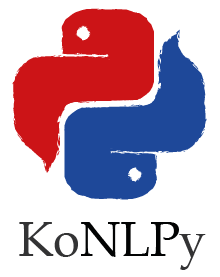Morphological analysis and POS tagging¶
Morphological analysis is the identification of the structure of morphemes and other linguistic units, such as root words, affixes, or parts of speech.
POS (part-of-speech) tagging is the process of marking up morphemes in a phrase, based on their definitions and contexts. For example.:
가방에 들어가신다 -> 가방/NNG + 에/JKM + 들어가/VV + 시/EPH + ㄴ다/EFN
POS tagging with KoNLPy¶
In KoNLPy, there are several different options you can choose for POS tagging. All have the same input-output structure; the input is a phrase, and the output is a list of tagged morphemes.
For detailed usage instructions see the tag Package.
See also
Korean POS tags comparison chart
Compare POS tags between several Korean analytic projects. (In Korean)
Comparison between POS tagging classes¶
Now, we do time and performation analysis for executing the pos method for each of the classes in the tag Package. The experiments were carried out on a Intel i7 CPU with 4 cores, Python 2.7, and KoNLPy 0.4.0.
Time analysis¶
Loading time: Class loading time, including dictionary loads.
Execution time: Time for executing the pos method for each class, with 100K characters.
Performance analysis¶
The performance evaluation is replaced with result comparisons for several sample sentences.
“아버지가방에들어가신다”
We can check the spacing algorithm through this example. Desirably, an analyzer would parse this sentence to “아버지가 방에 들어가신다” (My father enters the room), rather than “아버지 가방에 들어가신다” (My father goes in the bag). Hannanum and Komoran are careful in spacing uncertain terms, and defaults the whole phrase to nouns. Kkma is more confident, but gets undesirable results. For this result, Mecab shows the best results.
| Hannanum | Kkma | Komoran | Mecab |
|---|---|---|---|
| 아버지가방에들어가 / N | 아버지 / NNG | 아버지가방에들어가신다 / NNP | 아버지 / NNG |
| 이 / J | 가방 / NNG | 가 / JKS | |
| 시ㄴ다 / E | 에 / JKM | 방 / NNG | |
| 들어가 / VV | 에 / JKB | ||
| 시 / EPH | 들어가 / VV | ||
| ㄴ다 / EFN | 신다 / EP+EC |
“나는 밥을 먹는다” vs “하늘을 나는 자동차”
If we focus on “나는” in both sentences, we can see whether an analyzer considers the context of words. “나는” in the first sentence should be “나/N + 는/J”, and in the second sentence “나(-ㄹ다)/V + 는/E”. :py:`.Kkma` properly understands the latter “나는” as a verb, wheras the rest observe it as nouns.
| Hannanum | Kkma | Komoran | Mecab |
|---|---|---|---|
| 나 / N | 나 / NP | 나 / NP | 나 / NP |
| 는 / J | 는 / JX | 는 / JX | 는 / JX |
| 밥 / N | 밥 / NNG | 밥 / NNG | 밥 / NNG |
| 을 / J | 을 / JKO | 을 / JKO | 을 / JKO |
| 먹 / P | 먹 / VV | 먹 / VV | 먹 / VV |
| 는다 / E | 는 / EPT | 는다 / EC | 는다 / EC |
| 다 / EFN |
| Hannanum | Kkma | Komoran | Mecab |
|---|---|---|---|
| 하늘 / N | 하늘 / NNG | 하늘 / NNG | 하늘 / NNG |
| 을 / J | 을 / JKO | 을 / JKO | 을 / JKO |
| 나 / N | 날 / VV | 나 / NP | 나 / NP |
| 는 / J | 는 / ETD | 는 / JX | 는 / JX |
| 자동차 / N | 자동차 / NNG | 자동차 / NNG | 자동차 / NNG |
“아이폰 기다리다 지쳐 애플공홈에서 언락폰질러버렸다 6+ 128기가실버ㅋ”
How do each of the analyzers deal with slang, or terms that are not included in the dictionary?
| Hannanum | Kkma | Komoran | Mecab |
|---|---|---|---|
| 아이폰 / N | 아이 / NNG | 아이폰 / NNP | 아이폰 / NNP |
| 기다리 / P | 폰 / NNG | 기다리 / VV | 기다리 / VV |
| 다 / E | 기다리 / VV | 다 / EC | 다 / EC |
| 지치 / P | 다 / ECS | 지치 / VV | 지쳐 / VV+EC |
| 어 / E | 지치 / VV | 어 / EC | 애플 / NNP |
| 애플공홈 / N | 어 / ECS | 애플 / NNP | 공 / NNG |
| 에서 / J | 애플 / NNP | 공 / NNG | 홈 / NNG |
| 언락폰질러버렸다 / N | 공 / NNG | 홈 / NNG | 에서 / JKB |
| 6+ / N | 홈 / NNG | 에서 / JKB | 언락 / NNG |
| 128기가실벜 / N | 에서 / JKM | 언 / NNG | 폰 / NNG |
| 언락 / NNG | 락 / NNG | 질러버렸 / VV+EC+VX+EP | |
| 폰 / NNG | 폰 / NNG | 다 / EC | |
| 질르 / VV | 지르 / VV | 6 / SN | |
| 어 / ECS | 어 / EC |
|
|
| 버리 / VXV | 버리 / VX | 128 / SN | |
| 었 / EPT | 었 / EP | 기 / NNG | |
| 다 / ECS | 다 / EC | 가 / JKS | |
| 6 / NR | 6 / SN | 실버 / NNP | |
|
|
ㅋ / UNKNOWN | |
| 128 / NR | 128기가실벜 / NA | ||
| 기가 / NNG | |||
| 실버 / NNG | |||
| ㅋ / UN |


